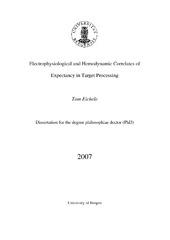Electrophysiological and Hemodynamic Correlates of Expectancy in Target Processing
Doctoral thesis
Permanent lenke
https://hdl.handle.net/1956/2509Utgivelsesdato
2007-11-20Metadata
Vis full innførselSamlinger
Sammendrag
Identifying patterns of recurrent events is central to human perception, cognition and behavior. By extracting patterns from the environment, individuals can make efficient predictions about future events. By and large, the detection of these contingencies is the core faculty to respond to, interact with, and ultimately make sense of the world. The aim of this thesis was to investigate how the brain treats temporal patterns and generates expectancies from regular event sequences. A variant of an auditory oddball paradigm was developed in which predictability was modulated with sequences of random and regular targets. In order to assess both the temporal and spatial implementation of these effects, single trial event related potentials and functional magnetic resonance imaging were employed. In the first paper, the effect of predictability on brain activity was studied with single trial ERPs, yielding sigmoid-shaped learning curves on CNV, N2 and P3. The second paper described a method for integration of single-trial ERP with fMRI data, and reported three spatiotemporal activation patterns during the P2, N2, and P3 in addition to the generic activation elicited by target stimuli. An additional modulation beginning during the N1 was extracted in the third paper that employed a method for parallel unmixing of concurrent EEG-fMRI data. The results of the thesis have implications for the understanding of ERP components, the concepts of how a standard representation is formed and how context is updated need to take into account the effects of predictability observed here. Furthermore, the thesis presents straightforward methods for single-trial ERP, and concurrent EEG-fMRI analysis that afford comprehensive spatiotemporal mapping of event-related processes in the brain.
